Simplifying Flies II
Trip Report 9-26-2015
The Overhand Worm
If you value the artistry and mystique of fly tying, read no further.
Simplifying Flies II is the second essay in a series inspired by Morgan Lyle's new book Simple Flies.
I have been attracted to simple flies for quite some time, probably ever since I first saw an image of one of the almost austere North Country wet flies. The North Country wets consist of no more than a silk thread body and a soft hackle feather. The silk doesn't even cover the whole hook shank and only one to one and a half turns of hackle is used. I once joked that when my Scottish forebears learned that three inches of silk thread and a wisp of feather would catch fish, using six inches of silk and two wisps of feather would have been considered sheer waste.
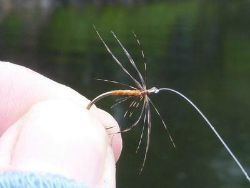 Partridge and Orange
Partridge and OrangeThe North Country flies are extremely effective, though, and are just as effective tied Sakasa style. My best ever tenkara trout was caught with a reverse hackled Partridge and Orange. (Update: I have since caught a larger trout on an Overhand Worm).
Other simple flies that have done well for me are of course the Killer Bug and Frank Sawyer's original Pheasant Tail Nymph - which is just pheasant tail and copper wire.
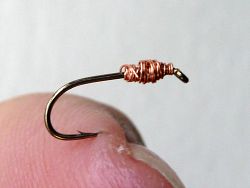 Bare Hook Nymph
Bare Hook NymphOliver Kite took the already simple Pheasant Tail Nymph and simplified it. His Bare Hook Nymph consisted of nothing more than a copper wire thorax. He noticed that fish still took the Pheasant Tail Nymph long after all the pheasant tail was torn away, leaving only the copper wire. I might add that Dale Hewitt, who won the Most Fish category of my recent No Vise Challenge had similar results, as his copper-wire reinforced Teeny Nymph was reduced to just copper wire but still kept catching fish.
I mentioned in my first Simplifying Flies essay that I had simplified the Pink Chenille Worm by leaving off the thread base. The simplified fly needed no more than ten turns of thead - maybe four turns to bind the thread to the hook, a couple more to hold the chenille in place and then a four-turn whip finish, which bound the chenille to the hook.
Well, yesterday I tried a Pink Chenille Worm that is even simpler. I truly believe it is the simplest fly you can tie. I had mentioned to Morgan Lyle that I had the world's simplest fly and of course he wanted to see a photo.
I told him that I would try it and if it didn't catch fish I would deny ever even having mentioned it.
And so, I headed up to the Catskills to fish the Beaverkill, without having tied a single fly.
Truth be told, the purpose for my trip was not to test out the World's Simplest Fly (and I realize it isn't the worlds simplest fly - Coach came up with an even simpler one but his wasn't tied - it was just blue fuzz glued to a tanago hook). The reason for the trip was to see if a keiryu approach (very long rod, very light line and split shot) would work on the Beaverkill, which is probably the most famous trout stream in the Catskills but which has always struck me as not being good tenkara water.
When trying to explain that feeling to someone who had never seen it, I described the Beaverkill as a river consisting of long glassy pools between long featureless riffles. I doubt there is a plunge pool on the entire river (except perhaps for the headwaters, which are closed to the public.)
As with waters in many areas, the "best" sections are "artificials only" (New York has almost no "fly fishing only" water). I could certainly use a keiryu rod, a keiryu line, split shot and a keiryu hook, but I certainly could not use a worm on the two "No Kill" sections (even though I had no intention of killing fish). My goal, then, was to create a simple fly that people could use with a keiryu rig when on fly fishing only water.
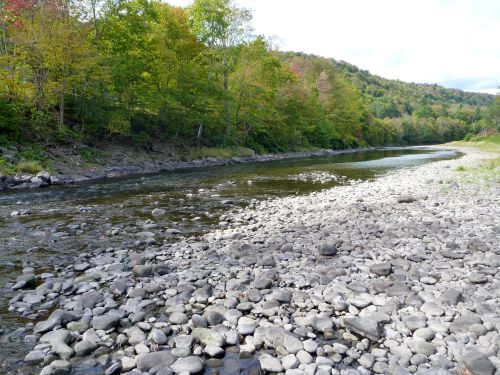
When I got there, I was shocked at how low the water was. This is one of those long glassy pools. The normal waterline, visible on the far bank, is well over a foot above the current water level. All the long featureless riffles I had described could now be described as long ankle to mid-thigh deep featureless riffles.
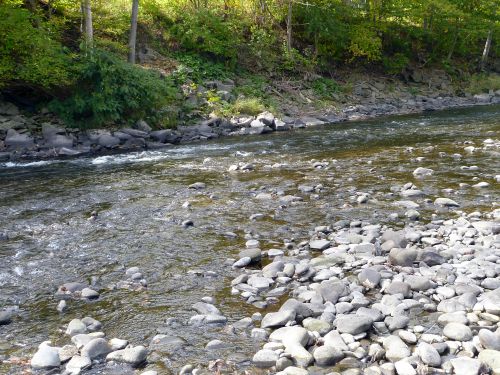
At the head of that long glassy (and low) pool was the most interesting water I saw the entire day. It was the only place I saw on the Beaverkill where a constriction had resulted in water that had both depth and current.
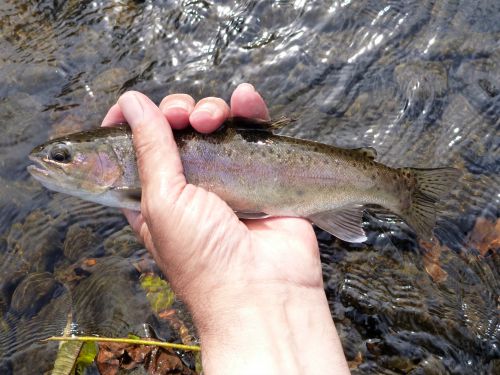
Since it was not in one of the "no kill" sections, I was able to try a full keiryu approach, and found found that it does indeed work in the Beaverkill, as this surprisingly dark rainbow proves. At more normal flows, I am pretty sure keiryu fishing would be productive over most of the stream.
The Willowemoc was also extremely low but I did find one spot that looked good. A constriction there, too, resulted in deeper water, which then flowed around a good sized rock midstream. That was where I first tried the "Overhand Worm" - with mixed success. My first fly, tied at the stream, was on a size 18 hook.
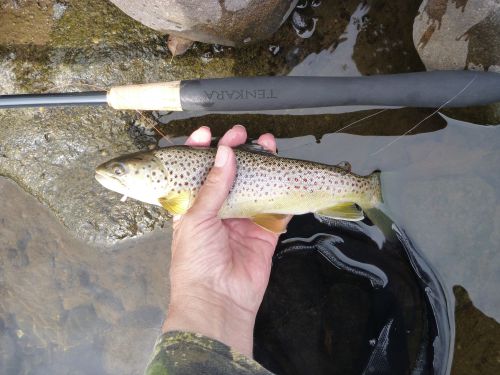
Casting behind and beside that rock quickly led to two takes. Both fish got off, though. The knot in the chenille closed off much of the bend in the hook, effectively shortening the hook point. I did manage to get the third fish into the net. After that, I went to a size 16 hook, which left more of the hook bend open. Later on, I switched to a short shank size 14, which I think is the best hook, and which is what I used to catch the fish shown with the tying sequence below.
I fish the Overhand Worm with a split shot roughly 4-6" above the worm. The size of the shot is based on water depth and current, but I generally use between a size 6 shot for low water up to a BB shot for deep water.
I used fly hooks rather than keiryu hooks for the Overhand Worm for two reasons. I had decided to try using eyed hooks for keiryu fishing to see if they worked as well as the traditional eyeless keiryu hooks. The Owner Mainstream Tenkara hook certainly does and could be a good choice for keiryu newbies who want the effectiveness and simplicity of keiryu fishing but don't feel the need to follow all the traditions - most notably snelling eyeless hooks. Also, I was just a little concerned that if I got questioned in one of the artificials only sections, which fishing with a 17 or 20 foot rod that obviously does not look like a fly rod might trigger, while using a "fly" that doesn't look much like a normal fly, at the very least I wanted it to be tied on an easily recognizable fly hook.
Since the fly did catch fish, here is the simplest fly you can tie.
Tying the Overhand Worm
1. Cut a length of Ultra Chenille, Micro, Fl. Pink the same width as the card (you can do this in advance, so you have them ready to go). The resulting "worm" is about 1.25" long
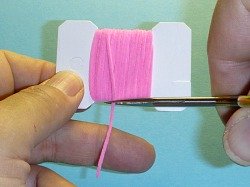
2. This photo shows all the materials you need: a short shank hook already tied to your tippet, and a pre-cut length of pink chenille.
This was my original tying sequence, but I now strongly recommend a different hook, either the Owner Wide-Eyed Hook™ or the Gamakatsu R10B (shown below).
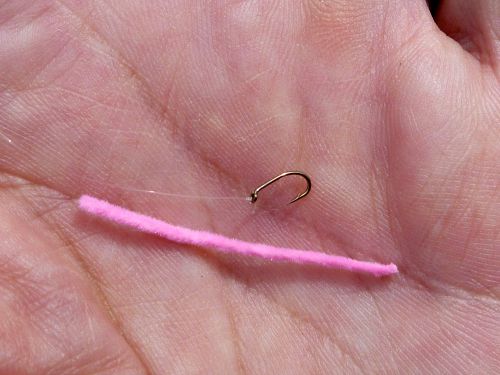
3. Tie an overhand knot in the chenille.
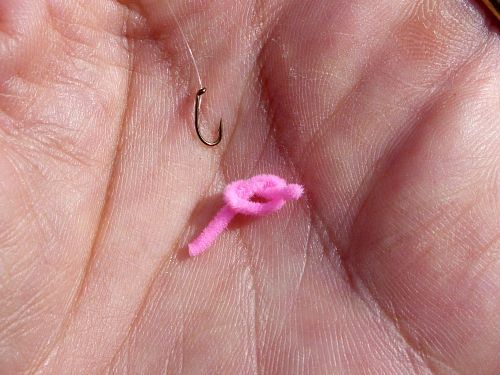
4. Hook the hook through the overhand knot.
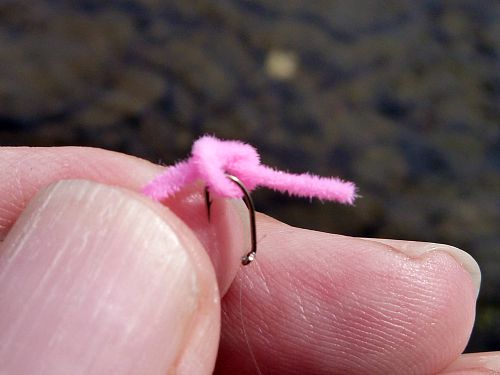
5. Tighten the knot. TIGHT. You can slide it up to the hook eye as shown, but before long it will slide back down to the bend by itself. May as well just leave it at the bend. If you tie them at home rather than on the streambank, a bit of head cement or superglue should keep the knot up by the eye if you wish.
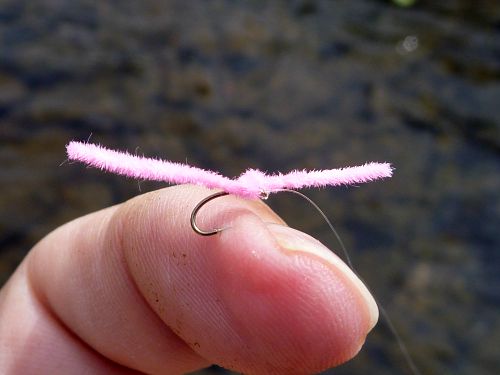
6. Catch fish!
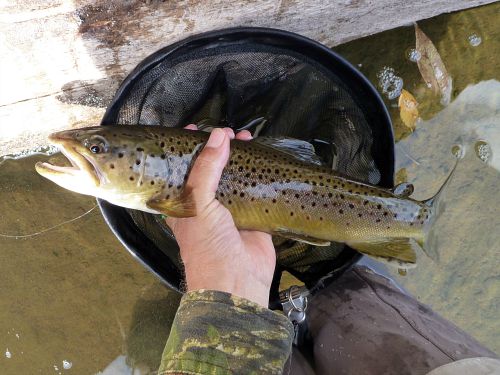
This fly (and it is indeed a fly as defined in the New York fishing regulations) is not at all artistic, and certainly there is no mystique surrounding it. It pretty much boils fly tying down to the basics. It doesn't require thousands of dollars in materials or hundreds of dollars in tools. You don't have to take lessons. It will not win any contests or get you an invitation to join the Fly Tyers Guild. Orvis is not going to ask me if they can put it in their next catalog. What it will do, though, is catch fish. For some people that's all that matters. For some, that doesn't matter at all.
Update: I have since found two hooks that work much better for the Overhand Worm than the fly hook shown in the tying sequence above.
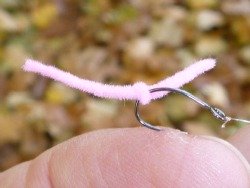 Owner Wide-Eyed Hook™
Owner Wide-Eyed Hook™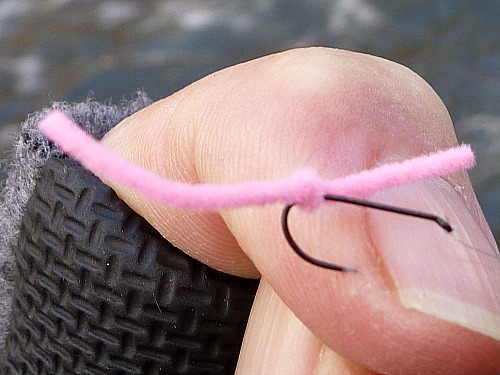 Gamakatsu R10-B Hook
Gamakatsu R10-B HookI now recommend either the Owner Wide-Eyed Hooks™ or the Gamakatsu R10B hooks. The shape of the bend in either hook keeps the knot from closing off the gape and provides better hook sets.
TenkaraBum Home > Trip Reports > Simplifying Flies II
“The bitterness of poor quality remains long after the sweetness of low price is forgotten” - Benjamin Franklin
"Be sure in casting, that your fly fall first into the water, for if the line fall first, it scares or frightens the fish..." -
Col. Robert Venables 1662
As age slows my pace, I will become more like the heron.
We've all had situations where seriously chewed up flies kept catching fish after fish after fish. It is no sin to tie flies that come off the vise looking seriously chewed up.
Warning:
The hooks are sharp.
The coffee's hot.
The fish are slippery when wet.
Beware of the Dogma
Seriously, all the hooks sold on TenkaraBum.com, whether packaged as loose hooks or incorporated into flies, are sharp - or as Daiichi says on their hook packages, Dangerously Sharp. Some have barbs, which make removal from skin, eyes or clothing difficult. Wear eye protection. Wear a broad-brimmed hat. If you fish with or around children, bend down all hook barbs and make sure the children wear eye protection and broad-brimmed hats. Be aware of your back cast so no one gets hooked.
Also, all the rods sold on TenkaraBum.com will conduct electricity. Do not, under any circumstances, fish during a thunder storm. Consider any fishing rod to be a lightning rod! Fishing rods can and do get hit by lightning!
What's in stock?
Kurenai II AR 30F
Kurenai II AR 33F
Kurenai II AR 39F
TenkaraBum 33
TenkaraBum 36
Furaibo TF39
Furaibo TF39TA
Nissin Oni Tenkara Line
Related Items
Dinsmore's Split Shot
Owner Mainstream Tenkara Hook
| That's just flat-out subversive!
Morgan L, New York |
| After tying thousands upon thousands of flies I have fly tying burnout. I totally get the simple fly approach.
John P, Ohio |
| Overhand knot worm. Love it! No weight, just soaked up chenille and the fish went crazy for it!!! Got about 20 gills and never lost the chenille.
Dale H, Wisconsin |
If you enjoy spin fishing or baitcasting please visit my sister site Finesse-Fishing.com.


